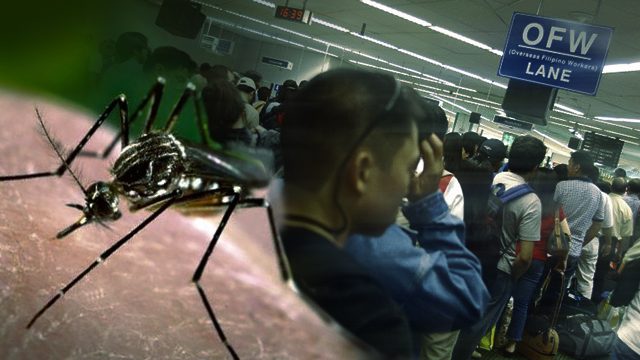SUMMARY
This is AI generated summarization, which may have errors. For context, always refer to the full article.

MANILA, Philippines – The World Health Organization (WHO) declared an international public health emergency on January 30 as the novel coronavirus (2019-nCoV) from China claimed more lives.
It is the 6th public health emergency of international concern (PHEIC) the WHO has declared since 2009. (READ: FAST FACTS: What’s next after novel coronavirus declared an int’l emergency?)
This coincided with confirmation from Health Secretary Francisco Duque III of the first case of the virus in the Philippines involving a 38-year-old woman who traveled from Wuhan, China via Hong Kong. (READ: ’Novel coronavirus’ or 2019 nCoV: What we know so far)
What happened in the past 5 incidents declared as a global public health emergency, and how were they handled?
Swine flu pandemic (2009)
After first being discovered in the United States in early 2009, the swine flu, or influenza A H1N1 pandemic was declared in June that same year. By this time, 74 countries and territories had confirmed infections.
According to WHO, swine flu was a new virus when it emerged and most people had no or little immunity to it. By February 2010, the death toll hit 16,000, mostly from countries with inadequate resources for widespread laboratory testing.
The outbreak was declared over in August 2010. While this does not mean the virus had been eradicated, WHO saw that it had “largely run its course.”
The US Centers for Disease Control and Prevention (CDC) estimated that 151,000 to 575,400 people died from the pandemic worldwide during the first year the virus circulated.
The H1N1 virus that caused the pandemic is now a regular human flu virus and continues to circulate seasonally worldwide. The manufacturers that produce seasonal flu vaccines produced the swine flu shot the same way seasonal vaccines are made.
Polio resurgence (2014)
The international spread of wild poliovirus was declared a PHEIC in May 2014. A spike of cases occurred in Pakistan, Syria, and Cameroon and began to spread to other countries.
WHO urged all residents and long-term visitors from the 3 countries to have themselves vaccinated before traveling and to provide proof of vaccination.
Inaccessibility remains to be a major risk, especially for several countries that have infection cases. These include Afghanistan, Nigeria, Niger, Somalia, Myanmar, and Indonesia.
As of January 2020, polio is still considered a PHEIC. Although wild poliovirus type 2 and type 3 have been eradicated, there are still cases of wild polio type 1 and vaccine-derived poliovirus types. Vaccine-derived polio type 1 was found in recent cases in the Philippines. (READ: PH declares polio outbreak as disease returns after 19 years)
There is no cure for polio, but it can be prevented by vaccination.
WHO reported a 99% decrease in wild polio cases, from 350,000 in 1988 to 33 in 2018.
In 2018, 85% of infants around the world received 3 doses of polio vaccine. The CDC however, recommends 4 doses.
Ebola epidemics (2014 and 2019)
Just 3 months after polio was declared a PHEIC, the same was done in the case of the Ebola virus disease in West Africa in August 2014.
Since Ebola is not airborne and can only be transmitted through direct contact with an infected person’s bodily fluids, WHO recommended no ban on travel or trade.
However, the WHO Emergency Committee recommended that countries still prepare to detect, investigate, and manage Ebola cases. This includes preparing their capacity to identify and care for travelers originating from Ebola-infected areas.
In 2016, when risk of international spread became low, WHO lifted the PHEIC status of Ebola. It had killed 11,300 people by then.
The second largest Ebola outbreak on record was declared on August 1, 2018, after occuring in the North Kivu and Ituri provinces of Congo. WHO named it a PHEIC in July 2019.
As of January 28, 2020, there are 3,302 confirmed cases, 2,242 deaths, and 1,154 survivors of the disease. The US Food and Drug Administration has had an Ebola vaccine since December 2019.
Zika virus (2016)
The Zika virus disease, which is caused by a virus transmitted primarily by Aedes mosquitoes, had been identified in humans since 1952. But in February 2016, reports came out that microcephaly, a condition where the head circumference is smaller than usual, and other neurological disorders were linked with cases of Zika in Brazil. This led to the declaration of a PHEIC due to their being extraordinary cases.
Zika infection during pregnancy was found to lead to such disorders in infants and other complications like stillbirth. The CDC advised pregnant women to avoid traveling to affected areas.
In May 2016, more than 100 doctors and scientists signed an open letter to WHO Director General Margaret Chan, calling for the Olympic Games in Rio de Janeiro to be postponed due to the Zika outbreak.
However, the WHO lifted the emergency status in November 2016 as research demonstrated the link of Zika and microcephaly. While the virus was still a challenge for WHO, the outbreak no longer constituted a PHEIC, following its definition.
By the end of 2016, the Zika virus had spread throughout the Americas and Europe, and in some parts of Asia and Oceania.The Pan American Health Organization reported 175,063 confirmed cases in the Americas. At least 57 cases were found in the Philippines in 2017.
Zika transmission still persists, but has generally been at low levels from 2018 to present. Currently, there is no vaccine or medicine for Zika, although development is underway. – Rappler.com
Sources: World Health Organization, AIMS Public Health, Centers for Disease Control and Prevention
Other updates on the novel coronavirus:
Add a comment
How does this make you feel?
There are no comments yet. Add your comment to start the conversation.